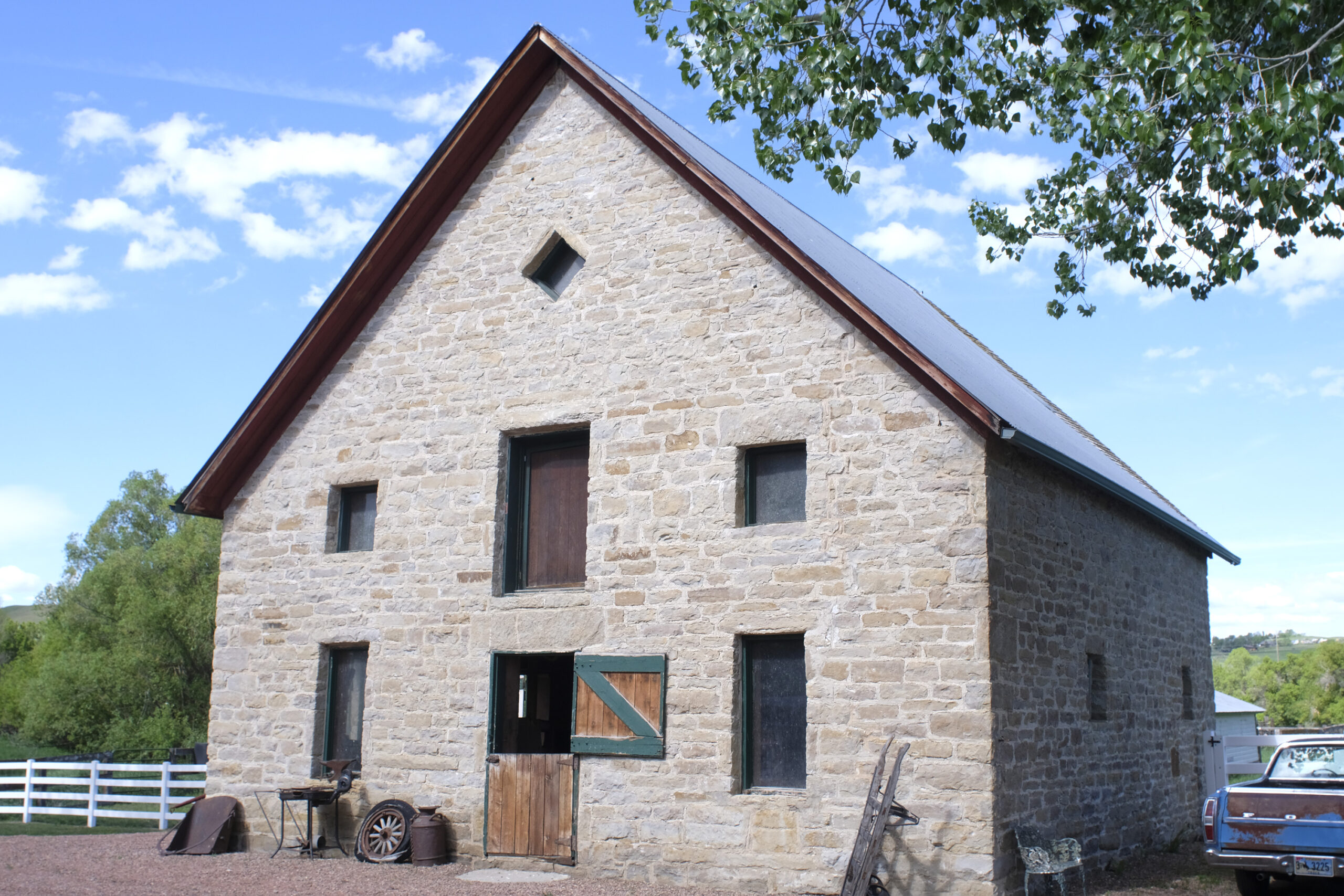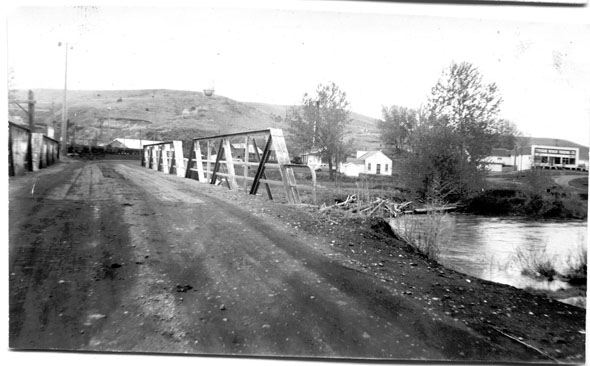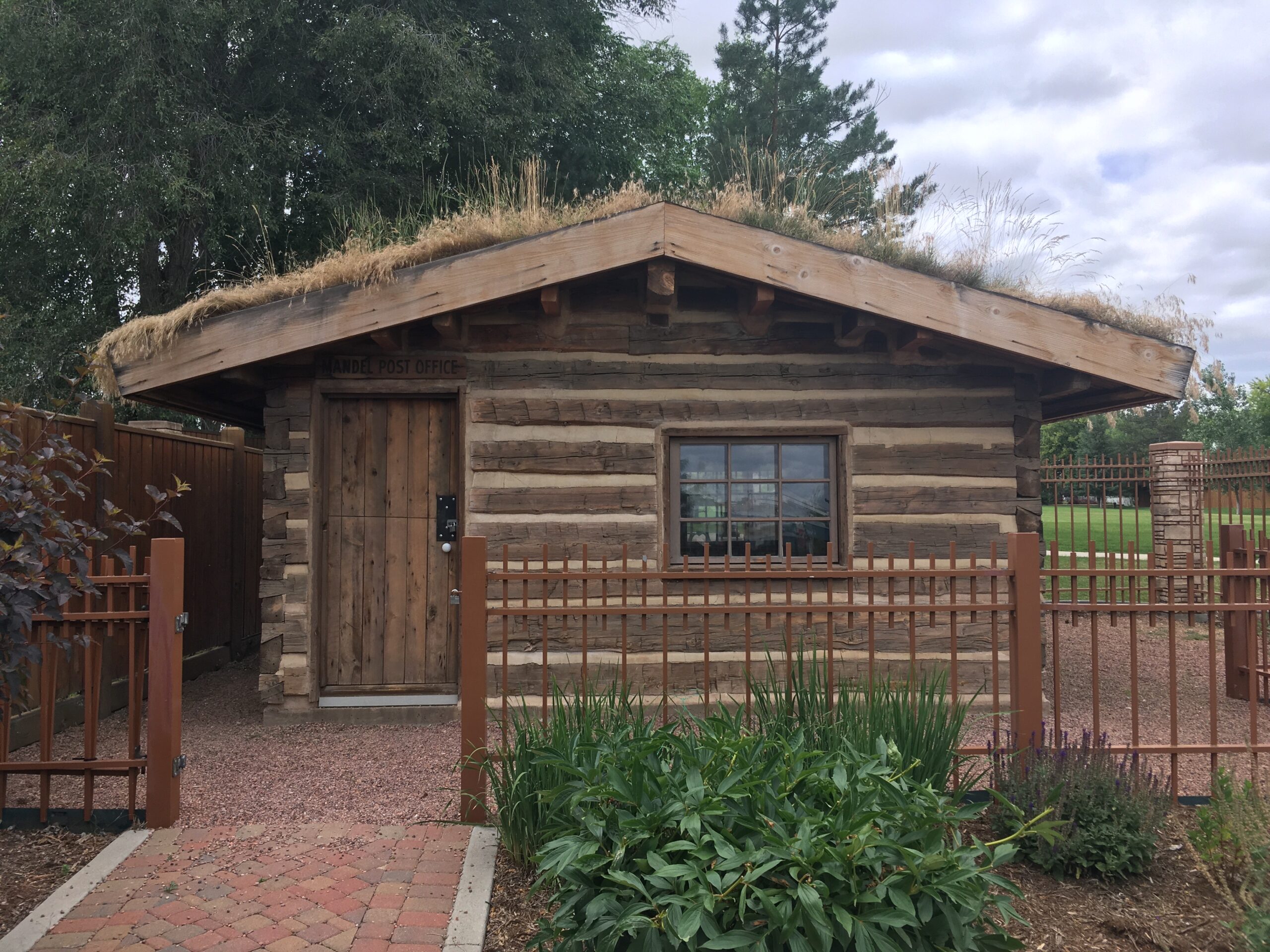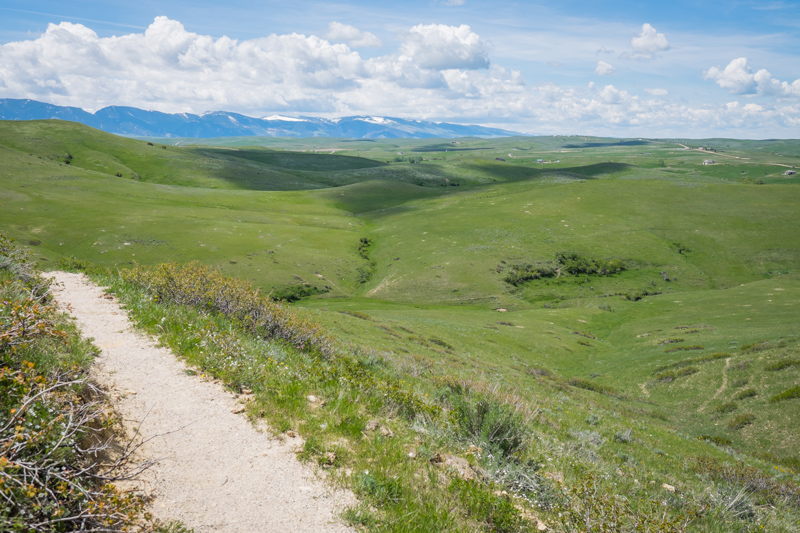
Color photo of the Mohns Center circa 1982, courtesy of the Wyoming Room, Sheridan Fulmer Library, Sheridan Wyoming.
For over seventy years, Sheridan College has been the mecca of learning for north central Wyoming. Developed as an agricultural junior college in the rich farming territory of Big Goose Valley, its development over the years was accelerated with generous philanthropic assistance.
In 1949 early classes were held at night in the old Sheridan High School. The next year, classrooms were expanded into the Sheridan City Council’s chambers at City Hall. In 1954 the college was moved to the Sheridan County Memorial Building and other locales around town.
Seeing that things were growing exponentially, Whitney Benefits Foundation stepped up and contributed eighty acres of land for a permanent college site.[1] In 1957 Wyoming resident, Frederic Thorne-Rider who was belted as a Count by Italian king Victor Emanuel in 1922, offered a gift of $250,000 to begin construction of the permanent campus.[2] The Whitney Benefits Foundation then matched the Count’s gift. The curricula during that period consisted mainly of agricultural pursuits, but slowly stepped into the arenas of science and health.
A place for dreamers and doers, over the years tremendously gifted individuals stepped into the limelight offering a distinct vision and desire to improve community education. In 1966 the science department took on a mover and shaker – Dr. Kenneth Ohm.
During his twenty-six year career at Sheridan College he developed an expansive curricula for Sheridan College’s science program leading the college into areas of science that had not previously been developed in Wyoming. His enigmatic energy brought a new wave of inspiration and learning to residents of Sheridan.
Ohm earned his BS and MS degrees in 1958 and 1961 from Emporia State University in Emporia, Kansas. He kicked of his teaching career in the fall of 1959 teaching physics at Manhattan High School, and astronomy at Kansas State University in Manhattan, Kansas. He completed his doctorate at the University of Wyoming at Laramie and taught physics in the University’s Prep School during his residency. In the fall of 1966 he accepted the position at Sheridan College.[3]
A dedicated and brilliant disciple of space, Dr. Ohm led the science department into study of the cosmos. Selected as Chairman of the Department of Physical Science at Sheridan College in the fall of 1966, he was later honored with a full professorship and appointments as Dean of Faculty and Director of Sheridan College’s observatory. His connections with NASA won him rare opportunities to attend Apollo space launches and to meet U.S. astronauts.[4]
Ohm’s energetic style was embraced by the Sheridan community as he continually sought creative ways to engage students and ignite their enthusiasm for science. His educational outreach to the community encompassed young and old, student and non-student. When space was then described as the final frontier, he led the college into the expanding fields of astronomy and solar energy. His indomitable drive fired not only the imaginations and curiosity of the community, but attracted funding from like-minded, mid-century philanthropists who believed in his vision. Like Count Frederic Thorne-Rider, and new generation of philanthropists with an interest in science education stood shoulder to shoulder with Ohm imagining and planning an observatory to investigate deep space and harness new technologies for the future.
Campaigning for development of an advanced astronomy program for Northern Wyoming Dr. Ohm spent ten years in planning. At the time, Sheridan’s location was considered one of the best areas for “dark skies” and a perfect environment for research into deep space. Sharing his ideas with various local citizens and business members – his dream soon became a reality. Dynamic community support was instrumental in the final realization of his vision.
In collaboration with industrialist Leslie Frederick Mohns, and Sheridan businessman George Ghikas, Dr. Ohm accelerated development of an astronomy program for the college. His connections to the community garnered private donations earmarked for what would become the Mohns Center of Science and Technology.
One afternoon Les Mohns stepped into Ohm’s classroom and handed him a check for $20,000; enough money to seed the dream, thus, launching the science center into reality. Ohm’s network of regional and national organizations heightened public interest.
However, Les Mohns was the financial iron horse behind the development. Six months later he donated another $20,000 continuing his financial support until the facility was completed. Mohns’ combined $40,000 gift was originally intended to be used for construction of a solar monitoring station in conjunction with the observatory. His gifts encouraged community involvement toward purchase of the observatory dome. The public funding goal was $5,000, which would later be matched by George Ghikas.
Ohm’s idea was to build an observatory on the outskirts of Sheridan – away from city lights. An early advocate for solar technology, his plans included research and development of alternative energy sources, particularly state of the art solar collection devices.[5]
Originally envisioned as a teaching tool, the Mohns Center was slated to be headquarters of the Wyoming Energy Extension Service and to serve as a classroom for astronomy.[6] Unfortunately, funding for the solar research project was eventually redirected, and the program mothballed.
Undaunted, Ohm struck out on his own to establish the Sun Company where he developed some of the earliest technology in the western U.S. while demonstrating its capabilities in conjunction with his own home.[7]
BREAKING GROUND

The building site for the science center was acquired through the Whitney Benefits Foundation. Groundbreaking commenced in November of 1977. Ohm, Mohns, Ghikas and Gordon Ward, president of the college, were on hand with shovels to launch the science and observatory complex. [8] In 1978, another $10,000 for the project was granted by Illinois Tool Works of Chicago where Mohns was a board member. Illinois Tool Works donations were typically pledged to colleges and universities from which future graduates could be recruited into the fields of scientific innovation.
Mohns’ continued support was impressive. In September of 1978 he donated an estimated $82,000.00 worth of stock to build the observatory and energy sciences complex. He later added an additional gift of five thousand shares of Illinois Tool Works stock, with an estimated value of $124,400.00. In the spring of 1979 Petro Construction Co. Inc. commenced construction of the building. The architect was Gordon Oliver of Sheridan.
The college’s curious student body paid close attention during construction of the building, noting the arched window of the lobby was reminiscent of restaurant architecture of the era. With tongue in cheek, the students pranked the building with a homemade sign joking about the coming of a Taco Bell to campus.
STRONG COMMUNITY SUPPORT
As Dean of Community Services, Ohm led a group of middle school students committed to assisting in funding the observatory. The Stargazers and Planet Watchers Society of Big Horn School raised money for the observatory dome. A matching gift was later presented by George Ghikas.
One afternoon, Ghikas invited Ohm to visit his coin shop on North Main Street, telling him that he had something special he wanted to show him. Stepping into the shop’s storeroom, Ohm was delighted to find a new 12.5” “Astrola” model telescope manufactured by the Cave Optical Company of Long Beach, California. Ghikas had purchased the instrument to complete the observatory equipment. Ghikas shared Ohm’s love of astronomy, and often invited students to view the planets and constellations through his personal telescope.
THE STAR MAN’S HOME – THE OHM DOME

Because of Mohns and Ghikas’ generous support, the observatory dome was completed November 17, 1979. A crew of four engineers from the Ash Dome Company of Plainfield, Illinois put the finishing touches on the professional, motorized observatory. [9]
In July of 1980, with the upcoming lunar eclipse of Jupiter on the horizon, Ohm and Tom Cox (a mechanical engineering student at University of Wyoming) fast tracked the telescope’s installation, executing collimation and final calibration. They were assisted by Owen Williams and Larry Macha.
The eclipse of Jupiter occurs every eighty-nine years, so it was a once in a lifetime event for the Wyoming astronomy community. That night the astronomers also viewed the Lagoon Nebula and Trifid Nebular in Sagittarius and other deep sky objects.[10] Dr. Ohm stated, “The telescope worked beautifully beyond my hope, and is proving itself in a most spectacular way.”

At the time, Sheridan College’s Cave Astrola telescope was the largest in the Intermountain West. Upon completion, the observatory facility included a darkroom equipped with photographic equipment including an astrophotography camera with infra-red and solar monitoring devices. Exact time signals from the shortwave radio station (WWV) in Fort Collins, Colorado were intercepted in the science center’s radio room then sent upstairs to the observatory to align the telescope. The observatory dome was featured in Sky and Telescope in 1978 in an advertisement for Ash Dome Company.
The science center’s Foucault pendulum was subsequently approved by the college and installed on October 1st 1980 by Steve Craig, the foremost authority in Foucault pendulums in America. Craig was curator of the Museum of the Golden Gate Academy of Science in San Francisco. At the time, the pendulum was the only one in Wyoming, and 38th in the world. Later, in 1988 Academy Pendulums installed another device in Rock Springs, then in 2007 another was established at Casper College.

The grand opening of the Mohns Complex occurred October 11, 1980, with an estimated three hundred visitors touring the new facility. Ohm’s popular Star Nights program began in October of 1981, attracting huge crowds.
Have you heard about the crater on the backside of the moon dubbed the Ohm Crater? Dr. Ohm was responsible for naming the feature for his ancestor, renowned physicist and mathematician George Simon Ohm after whom the unit of electrical resistance is named.[11] After the Apollo 8 moon shot, Ohm wrote to the “International Lunar Nomenclature group in Switzerland and suggested that one of the prominent craters be named after his family’s namesake ancestor. He received an immediate and positive reply.
Within months the Ohm Crater was established at 18.4 N and 113.5 W on the far side.” [12]

During the 1970’s and 80’s Ohm was a guest contributor for the Sheridan Press, writing a regular column titled, “The Skies.” Residents were enthralled with his work and eagerly supported his passion to teach the community about cosmology.
Always on alert for upcoming celestial events, Ohm invited all Wyoming residents to join him when he and his colleagues hosted the community in witnessing Wyoming’s dramatic night skies and planetary events. Star Nights were always well attended with as many as two hundred people coming together to enjoy, as Carl Sagan would say, star stuff!
Participants often traveled with Ohm to get spectacular viewing opportunities. One such event was a trip into Montana to view a total solar eclipse on February 26, 1979. Sixty participants from Sheridan boarded a bus for Livingston. Armed with welder’s shields they trekked two hundred and fifty miles for the once in a lifetime show. One journalist noted, “objective journalism fell by the wayside” when she viewed one of the most spectacular events human beings can experience.[13] No wonder primitive people stood in awe, or fright, when this and similar events occurred.
Another event occurred in 1986 when Ohm acolytes witnessed the return of Halley’s Comet which passes our blue planet every seventy-six years. It was named after Edmund Halley who calculated its orbit and accurately determined when it would swing by earth in the future. The first time it was seen, was in 1066 before the Battle of Hastings in England. Sheridan observers numbered in the hundreds as Dr. Ohm directed their attention to the heavens over the Bighorn’s towering peaks seeking the comet’s tiny sparkling tail which produced an indelible streak across the firmament.[14]
Later, at the request of J. Allen Hynek, Director for the Center for UFO Studies at Northwestern University, Sheridan College’s Science Department became the UFO clearing house for Wyoming.[15] Whether little green men were sighted is unknown as the record book has unfortunately disappeared. According to Ohm, most reported sightings tended to occur around Casper.
NATIONAL AERONAUTICS AND SPACE ADMINISTRATION
In the 1960’s when the space program was just getting off the ground, Ohm became an avid observer of projects launched by the U.S. Government and NASA. In December of 1972 he was invited to the Apollo XVII launch where he was able to share ideas with his peers. In 1983 he applied for a future Space Shuttle Mission as a citizen observer. In 1987 Ohm participated in NASA’s Aerospace Education Service Project. [16]
In October of 1988 he commenced Project Genesis, dubbed “Wyoming in Space.” Working in conjunction with NASA, Ohm was project manager with Jim Banks serving as coordinator during planning phases. The project was open to northeastern Wyomingites who were encouraged to design and/or select experiments to be placed aboard a future space shuttle launch. A small self-contained payload would hold what NASA called a “Get Away Special” (GAS). At the time, Ohm stated, “Project Genesis is a vehicle designed to encourage individual creativity and the involvement of people outside the scientific community.”
Other payload groups working on their own GAS projects were the Naval and Air Force Academies, California Institute of Technology (Steven Spielberg was project manager) and MacDonald-Douglas. Advisory committee nominees included well-known individuals such as, John Denver (singer), John Glenn, and Neil Armstrong (astronauts) along with several political figures.[17]
As an educator Ohm has been praised as an exceptional leader and good citizen. Chosen on the basis of his professionalism and civic participation, he was lauded by the United States Senate as an Outstanding American Educator. Continually developing curricula, he provided syllabi for instructors at all levels.[18] A multifaceted leader, Ohm participated in the Division for Community Service, which offered leadership development and facilitation. He was also Chairman of the Wyoming Health Training Network. [19]
Dr. Ohm was appointed as a member of the Wyoming Science Technology and Energy Group by the U.S. Science Technology and Energy Authority in 1985. In 1989 he was reappointed to the same post by Wyoming Governor Mike Sullivan for a continuous four year term from 1989 to 1993. Senator Russel Zimmer, President of the Wyoming State Senate, confirmed his appointment. In 1990 he was named Outstanding Faculty Member at Sheridan College and became involved with the Sheridan College Foundation.[20]
In 1992 Sheridan College partnered with the Abrams Planetarium at Michigan State University to participate in “Moon Watch.” Viewers in dozens of national locations scientifically recorded the first visual sighting of the new moon with the naked eye. The Moon Watch event, occurred on June 1, 1992. [21]
Dr. Ohm’s passion for science doesn’t end with astronomy. In 1988 he was exploring the countryside outside of Laramie and noticed an interesting hogback formation off a rural road. Pulling up to the nearby ranch house, he asked the owner if it was possible to investigate the geologic formation on his property. Given the okay, his investigation turned up dinosaur bones laying along the base of the formation. Geologically the area is part of the Morrison Formation which has been Nirvana for diggers for over a century. Picking up a few samples, he went back to the rancher and asked if he could collect more specimens. The gentleman said, “Of course, take whatever you want.”
Happily, Ken loaded up his convertible with as much material as he could carry and took it to the University of Wyoming’s geology department in Laramie for identification. They confirmed his prehistoric suspicions, but were uninterested in further investigation.[22] Consequently, Ohm decided to mount his own investigation with an associate the following season. Sadly, that winter his colleague was involved in a fatal snow machine accident and Ohm’s paleontology quest faded. He still dreams of his spectacular find after all these years. Searching Google maps and other topographical aids from the comfort of his home, he continues to seek the elusive location of his fossil find in hopes that he can direct others to the location to reap its rewards.
THE PHILANTHROPISTS
Leslie Frederick Mohns died on June 6, 1979, before the Mohns Science Center was dedicated. He was owner of Damascus Steel Co. in Rockford, Illinois, and owned a ranch in Dayton, Wyoming. During the Korean War he developed a method for manufacturing shell casings without seams – a major breakthrough in the fabrication of ammunition. Always striving to enrich the community he loved, the science center was named for him.[23]
George Ghikas was a naval veteran. After World War II, he received the Victory Medal and moved to Sheridan with his wife Venus. Successful in the hospitality industry they owned two cafés in Sheridan and the Sheridan Coin Shop. Ghikas continued living in Sheridan until his death on December 21, 2010.[24]
Before Dr. Ohm left Sheridan, many more space events took place with thousands of attendees. Responding to his mother’s health issues, he and his family left Sheridan in June 1992. Now retired, he currently resides in the Midwest with his wife Ruth where he has taken up the pen and has written several folksy books which are available on Amazon. Always engaged in pursuit of science, he continues to reach for the stars.
AFTERWORD
Following Dr. Ohm’s departure, focus of the science center’s original goal has contracted over the past thirty years. Interest in the astronomy program has faded. The large inventory of astronomical and scientific equipment fell into disuse. Unfortunately, light pollution and other factors have rendered utilization of the dome difficult for observational purposes. In recent years the Mohns Center was repurposed as the Museum of Discovery, featuring geology and paleontology exhibits. The building is slated to undergo renovations. Meanwhile, a dedicated group of volunteers have taken up the spirit of Dr. Ohm’s work and are currently working to resurrect an astronomy program for the college.
AUTHOR’S NOTE: Some historical photos and newspaper articles were originally provided by the Wyoming Room, Sheridan Fulmer Library, Sheridan, Wyoming. The majority of documentational content contained in this article was provided Dr. Ohm from his voluminous records and correspondence. All material has been donated to the Wyoming Room at Sheridan Fulmer Library, Sheridan, Wyoming with the permission of Dr. Ohm.
_____________________________________________________________________________

This is the original telescope that was in the observatory dome. This photo is from http://www.cave-astrola.com/telescopes/index.html
[1] Whitney Benefits Foundation was set up at the behest of Wyoming pioneer Edward Whitney in his 1917 will and continues to support educational philanthropy in the City of Sheridan.
[2] Sheridan Press, Gertrude Spomer, February 11, 1959, page 6. (2) Sheridan Press, February 11, 1959, page 8. (3) Billings Gazette May 17, 1963, page 5.
The Count was an interesting character. A rarified philanthropist with a personal hunger for education he held four advanced degrees (Ph.B, M.A. Ph.D and LL.D) from various prestigious colleges in the U.S. and India. His philanthropic nature won him the title of “Count” bestowed upon him by King Victor Emanuel of Italy. He was also conferred as Papal Chamberlain by the Vatican, a position granted to high-ranking clergy and laypersons. His home in Buffalo still stands. He moved to Sheridan in 1946.
https://dcwy.org/documents/2020/7/History%20of%20the%20History-1.pdf p. 130-1. https://www.newspapers.com/article/40991387/obituary_for_frederic_thorne_rider_ag/
[3] Personal correspondence/interview with Dr. Ohm.
[4] Ohm’s personal correspondence from NASA. (2) The Bugler, November 1983, p. 4. (3) Sheridan Press, December 1972. Apollo launch of December 1972.
[5] Sheridan Press, Thursday, April 17, 1980, article by Birkholz, Dick W., Ph.D., Natural Science Division of Sheridan College.
[6] Sheridan Press July 17, 1980, page 1 column 2
[7] Sheridan Press, Thursday, October 12, 1978, Solar Energy Tech. (2) Original fliers and advertising for Sun Company owned by Ohm.
[8] Photo from Sheridan Press.
[9] Invoice from Ash Dome Company. Author’s files. “November 1979, delivery and erection, technician supervisory service charges for a 14′ 6″ dia. Ash-Dome to your observatory site in Sheridan as authorized by your above reference P. O. #ASF No. 431, Paid: $1,904.00. Olson Development Co. delivery from Ash Dome Co. Plainville, Illinois.”
[10] Sheridan Press, July 17, 1980, page 1, column 2.
[11] Author’s personal correspondence/interview with Dr. Ohm.
[12] https://www.celestis.com/participants-testimonials/dr-kenneth-r-ohm/
[13] Sheridan Press, Wednesday, February 28, 1979, p. 20. By Linda Janssen Gjere.
[14] Sheridan Press, Wednesday, August 7, 1985.
[15] Personal Correspondence with J. Allen Hynek, Director, Center for UFO Studies, Evanston, Illinois. November 23, 1975.
[16] Personal correspondence to Dr. Ohm from Dr. Kenneth E. Wiggins, Project Director of NASA Aerospace Education Services Project. May 13, 1987. (2) Sheridan Press, December 1972. Apollo launch. (3) The Bugler, November 1983, p. 4.
[17] Sheridan Press, October 20, 1988.
[18] Personal correspondence to Ohm from the Wyoming State Legislature, Senator Russell W. Zimmer, President of the Senate, February 28, 1989.
[19] Personal correspondence to Ohm as Chairman of the Board of Directors – no date.
[20] Personal correspondence to Ohm from Mike Sullivan, Governor of Wyoming March 1, 1989. (2) Personal correspondence from Robert W. Koester, Executive Director of Sheridan College Foundation to Ohm May 17, 1990.
[21] Personal correspondence with Abrams Planetarium (Moon Watch report by Dr. Ohm to Mr. Robert Victor, Director).
[22] Letter to Dr. Ohm from Brent H. Breithaupt, Museum Curator, The Geological Museum, The University of Wyoming Department of Geology and Geophysics, Laramie, Wyoming, December 9, 1988.









